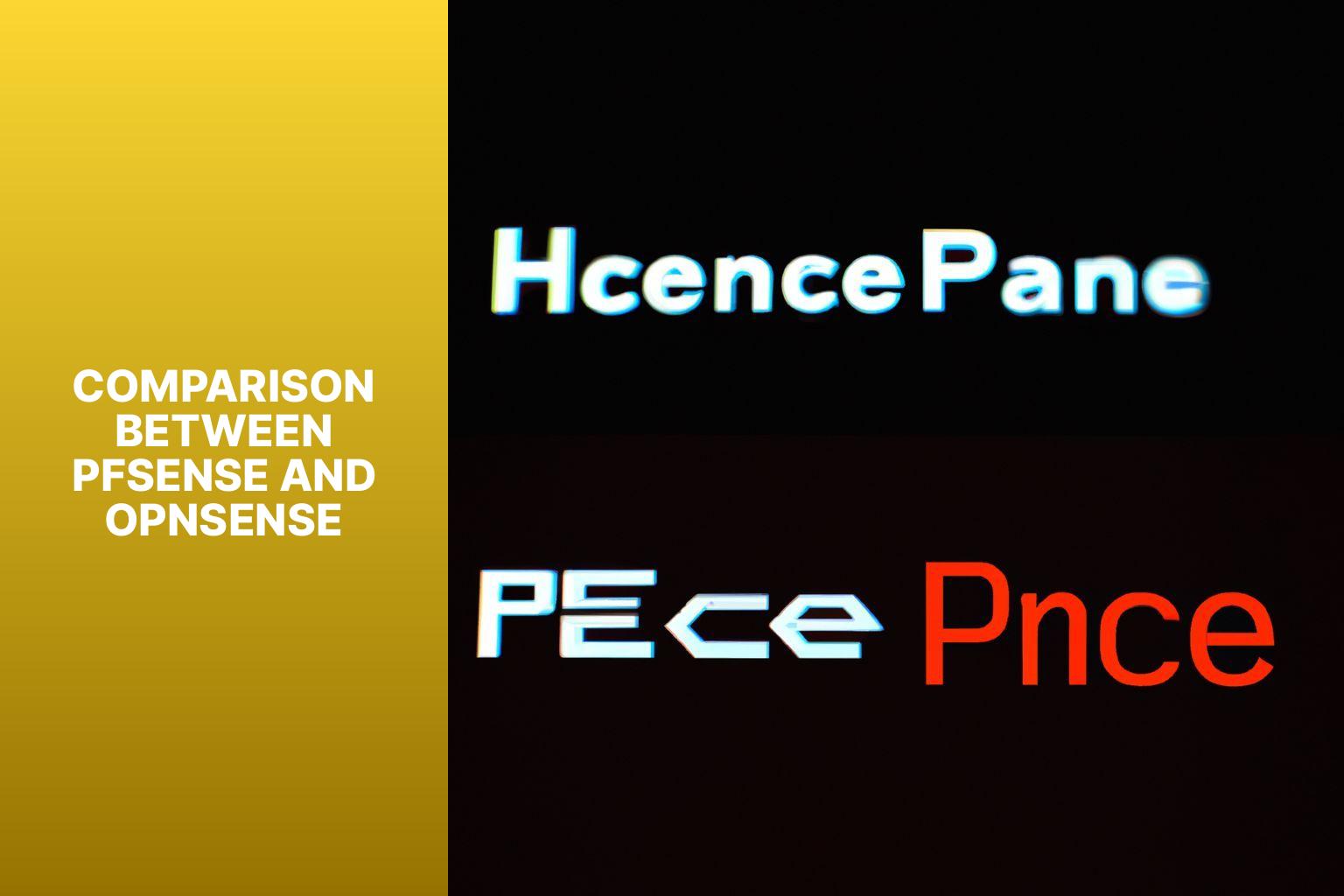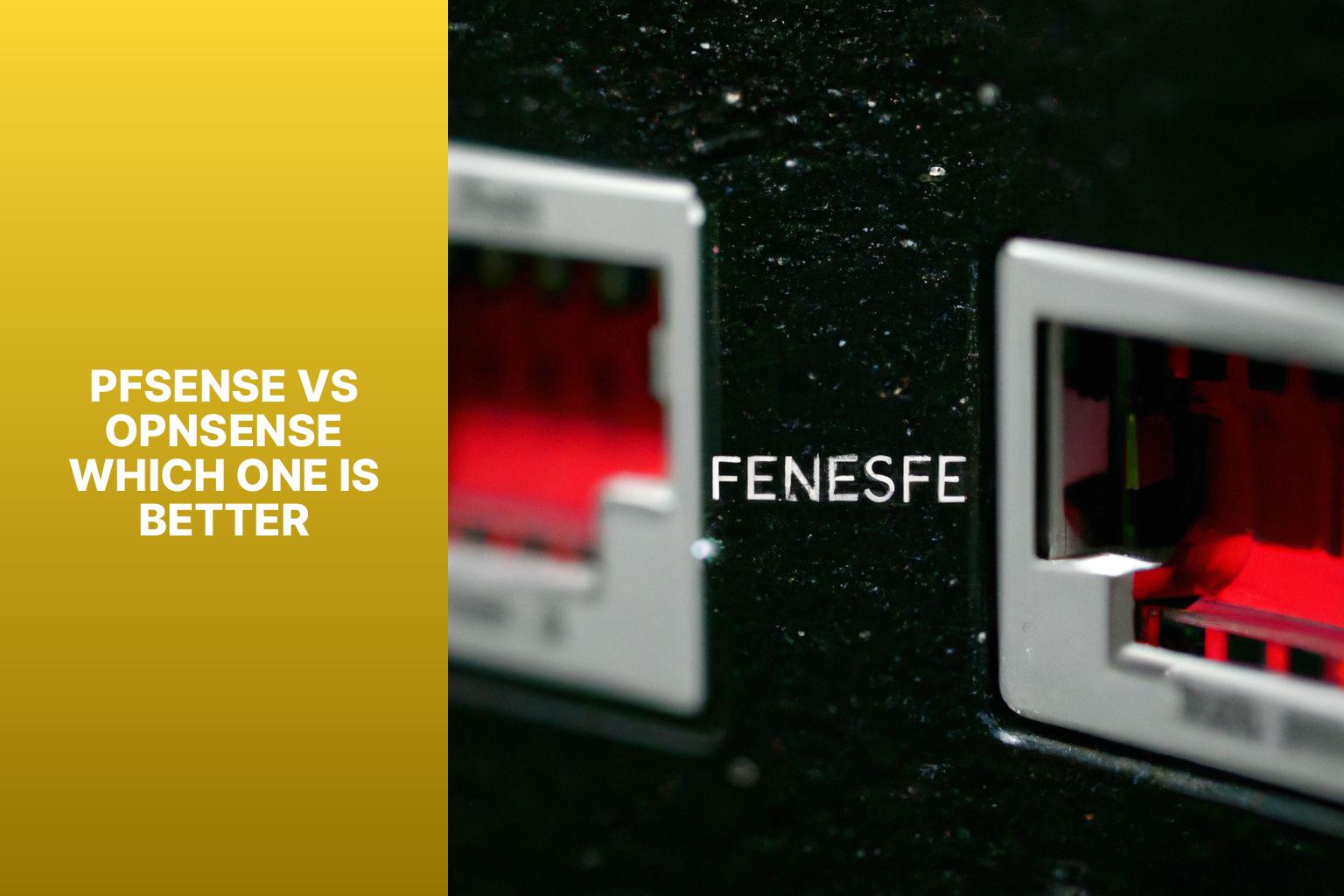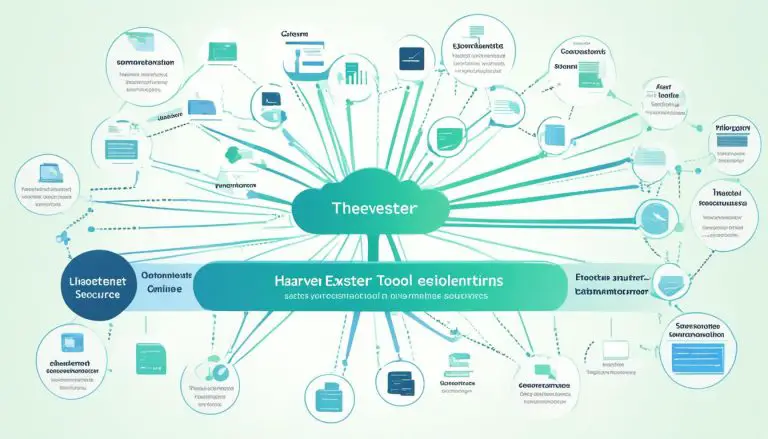pfsense vs OPNsense – a comprehensive comparison to determine the better option for your network security needs
When it comes to choosing a firewall and routing platform for your network, two popular options are pfSense and OPNsense. Both pfSense and OPNsense are open-source firewall solutions that offer a wide range of features and customization options. Understanding the differences between these two platforms is crucial in determining which one is better suited for your needs.

Both pfSense and OPNsense offer high customizability. Users can configure firewall settings, create advanced rules, and customize the interface. Both solutions support extensive add-on packages for enhancing functionality.
When comparing pfSense< and OPNsense, consider which features align with your requirements and expertise. Factors to consider include the need for code customization, interface customization, and the availability of add-ons.
It’s important to note that while the software is free, there may still be costs associated with hardware requirements. Both pfSense and OPNsense can run on a wide range of hardware, but larger-scale deployments or specific hardware requirements may necessitate additional investment.
Another financial consideration is the long-term costs of maintaining and updating the firewall. Both pfSense and OPNsense receive regular updates and development, ensuring ongoing security and feature enhancements. There may be costs associated with acquiring technical expertise for managing and maintaining the firewall over time.
Ultimately, the financial impact of choosing between pfSense and OPNsense depends on your specific requirements, technical expertise, hardware needs, and desired level of support. It is essential to evaluate these factors and assess the overall costs involved to make an informed decision.

What is pfSense?
pfSense is a free, open-source firewall and routing platform that is built on the FreeBSD operating system. It offers a robust set of features, including VPN support, traffic shaping, load balancing, and intrusion detection. pfSense has a user-friendly web-based interface and is backed by a strong community of users and developers.What is OPNsense?
OPNsense is another open-source firewall and routing platform that is based on the FreeBSD operating system. It was forked from pfSense in 2015 and has since gained its own following. OPNsense offers similar features to pfSense, including VPN support, traffic shaping, and intrusion detection. It also has a user-friendly web-based interface and an active community of users. To determine which one is better, let’s compare the key features and aspects of both pfSense and OPNsense.Key takeaway:
- pfSense and OPNsense are both powerful firewall solutions with distinct features and strengths.
- User Interface: pfSense has a more user-friendly interface, making it easier to navigate and configure, while OPNsense provides a sleek and modern interface.
- Community Support: Both pfSense and OPNsense have active communities, but pfSense has a larger and more established user base, providing a wealth of knowledge and support.
- Security Features: Both solutions offer robust security features like VPN, firewall rules, and intrusion prevention systems, ensuring the network’s safety.
- Customizability: OPNsense offers more flexibility in terms of customization, allowing users to personalize the system to their specific needs.
- Updates and Development: pfSense has a more frequent update cycle and a longer track record of development, ensuring regular bug fixes and feature enhancements.
- Purpose and Requirements: Choosing between pfSense and OPNsense depends on the specific requirements and purpose of the network.
- Technical Expertise: OPNsense requires a higher level of technical expertise for configuration and management, while pfSense offers a more user-friendly experience for beginners.
- Compatibility and Integration: Both solutions provide compatibility with a wide range of hardware and software, ensuring seamless integration into existing environments.
- Scalability and Performance: pfSense excels in scalability and performance, making it suitable for large networks with heavy traffic loads.
- Financial Impact: OPNsense is a more cost-effective option as it is an open-source solution, while pfSense offers additional paid support options.
- Security: Both solutions prioritize security, but pfSense has a longer track record and a larger user base, contributing to its reputation as a secure platform.
- Hardware: pfSense has wider hardware compatibility, allowing users to choose from a broader range of devices and configurations.
- User Experience: The choice between pfSense and OPNsense depends on individual preferences, with pfSense offering a more beginner-friendly experience and OPNsense providing a sleek and modern interface.
- Support and Documentation: Both solutions have extensive documentation and support options, but pfSense has a larger user community and more comprehensive resources.
What is pfSense?
Discovering the world of pfSense, an open-source firewall distribution, holds a fascinating array of possibilities. Let’s embark on a journey to explore what pfSense is all about. Unveil the key features that set it apart and make it a formidable contender in the realm of network security. Brace yourself for a deep dive into the realm of pfSense, where robust capabilities and enhanced protection await.Key Features of pfSense
– – Firewall and Router Functionality: pfSense serves as a firewall and router, delivering advanced network security and routing capabilities. – VPN Support: pfSense smoothly integrates with various VPN protocols to ensure secure remote access and site-to-site connections. – High Availability and Load Balancing: pfSense supports high availability and load balancing configurations to ensure uninterrupted network connectivity and efficient distribution of network traffic. – Multi-WAN Support: pfSense allows the usage of multiple WAN connections for redundancy and load balancing across various internet connections. – Traffic Shaping and Quality of Service: pfSense enables precise control over bandwidth allocation, prioritizing specific types of traffic, guaranteeing optimal performance for essential applications. – Intrusion Detection and Prevention System (IDS/IPS): pfSense incorporates IDS/IPS functionality, actively monitoring network traffic for malicious activities, and promptly blocking them. – Captive Portal: pfSense offers a captive portal feature for guest network authentication and access control. – Reporting and Monitoring: pfSense provides comprehensive reporting and monitoring capabilities to track network activity and troubleshoot issues effectively. – Extensibility and Customizability: pfSense supports a wide range of third-party packages and extensions, allowing for extensive customization and seamless integration with other systems and services.What is OPNsense?
OPNsense, the focus of this section, is a powerful and feature-rich open-source firewall solution that is giving pfsense a run for its money. In the following paragraphs, we’ll dive into the key features that make OPNsense a standout choice for network security enthusiasts and professionals alike. So, buckle up and get ready to explore the exciting world of OPNsense!Key Features of OPNsense
In recent years, there has been an increasing demand for open-source firewall solutions that provide more control and flexibility over network security. OPNsense offers a powerful firewall to control network traffic and enhance security, making it a reliable and flexible open-source firewall solution. OPNsense also supports VPN protocols like IPsec, OpenVPN, and WireGuard, making it easy to create secure remote connections. It allows administrators to block access to specific websites or content categories for added security and control, providing web filtering capabilities. OPNsense incorporates an Intrusion Detection and Prevention System (IDS/IPS) to detect and prevent unauthorized access, malicious activities, and network attacks. Users can also prioritize or limit bandwidth for specific types of network traffic through OPNsense’s traffic shaping feature, ensuring optimal performance and preventing congestion. Another key feature of OPNsense is its support for high availability. It can support redundant firewall systems that automatically failover in case of hardware or network failures, ensuring continuous network availability. OPNsense also offers various user authentication methods, such as local user management, Active Directory integration, and RADIUS support, for secure access control. It provides detailed logging and reporting features for monitoring network activities, detecting potential issues, and generating reports for compliance and analysis purposes. Leveraging the foundation of pfSense, OPNsense has become a reliable and flexible open-source firewall solution that meets the security and networking needs of users while providing extensive community support and customizable options.You may also read:
Powered by Inline Related Posts
Comparison between pfSense and OPNsense

Photo Credits: Www.Howto-Do.It by Matthew Ramirez
When it comes to pfSense and OPNsense, there’s a lot to consider. In this comparison, we’ll dive into various aspects that differentiate these two firewall solutions. From user interface and community support to security features and customizability, we’ll explore the strengths and weaknesses of each one. We’ll also touch on important factors like updates and development, technical expertise, compatibility and integration, scalability and performance, financial impact, security, hardware, user experience, and support and documentation. Let’s discover which option takes the crown!User Interface
The user interface is an essential aspect of both pfSense and OPNsense firewall solutions. It greatly impacts the user’s experience and efficiency. To determine which one is better suited for your needs, it is important to compare the user interface of these two solutions. When comparing the user interface, there are several key factors to consider. First, let’s look at intuitiveness. pfSense is known for being easy to navigate and use, while OPNsense is praised for its simplicity and user-friendly design. Customizability is another important aspect. pfSense offers high customization options, allowing users to tailor the interface to their specific needs. On the other hand, OPNsense provides extensive options for customization, providing flexibility in configuring the interface. Visual design also plays a role in the user interface. pfSense is recognized for its clean and organized design, creating a clutter-free experience. OPNsense, on the other hand, boasts a modern and visually appealing interface, enhancing the aesthetic experience for users. Next, let’s consider the dashboard. pfSense offers a comprehensive and informative dashboard that provides users with all the necessary information at a glance. OPNsense, on the other hand, offers a versatile and customizable dashboard, allowing users to personalize the display according to their preferences. When it comes to logging and monitoring, both pfSense and OPNsense excel. pfSense provides real-time monitoring and detailed logs, allowing users to track and analyze network activities effectively. OPNsense, on the other hand, offers a robust logging and monitoring system, providing comprehensive insights into network performance. Configuration wizards are another essential feature to consider. pfSense provides step-by-step guidance through its configuration wizard, ensuring ease of setup for users. OPNsense, on the other hand, offers a variety of wizards to assist users in configuring different aspects of the system. Package management is also important in the user interface. pfSense has an integrated package manager, making it easy to install and manage additional packages. OPNsense, on the other hand, has an extensive package management system, providing users with a wide range of options. Both pfSense and OPNsense prioritize multi-language support. pfSense offers support for multiple languages, ensuring a global user base can utilize the interface. OPNsense goes a step further by providing multilingual support, catering to users who prefer localized interfaces.Community Support
Community support plays a crucial role in the decision-making process when comparing pfSense and OPNsense. Both of these platforms boast thriving communities comprised of developers, contributors, and users. These communities serve as valuable resources for individuals seeking assistance, posing questions, and sharing knowledge. The developers actively engage within these communities, providing much-needed support and addressing user inquiries. They continuously roll out updates and security patches to guarantee platform stability and reliability. To further assist users, both pfSense and OPNsense offer extensive user forums and comprehensive documentation, which encompass important information, tutorials, and troubleshooting guides. The open-source nature of these platforms fosters community contributions, leading to the creation of plugins, extensions, and additional features that enhance the platforms’ functionality and ease of use. Thanks to their robust community support, both pfSense and OPNsense are compatible with a vast array of third-party integrations. Users can tap into these integrations to expand the capabilities and flexibility of their network security solutions. By thoroughly evaluating the strength and responsiveness of community support, users can make well-informed decisions between pfSense and OPNsense, based on their specific requirements and needs.Security Features
The security features of pfSense and OPNsense are fundamental considerations when selecting a firewall solution. It is essential to evaluate key security features such as firewall rules, intrusion detection and prevention systems (IDS/IPS), virtual private network (VPN) support, content filtering, and multi-factor authentication (MFA). Both pfSense and OPNsense offer advanced firewall rules that provide precise control over network traffic. These rules play a crucial role in safeguarding against unauthorized access and potential threats. Additionally, pfSense and OPNsense come equipped with built-in IDS/IPS functionality. These systems continuously monitor network traffic, promptly detecting and preventing real-time network attacks. Suspicious or malicious activities can be automatically blocked, ensuring enhanced security. Both pfSense and OPNsense support various VPN protocols, including IPsec and OpenVPN. This capability ensures secure remote access by encrypting data transmitted between remote devices and the network. As a result, confidentiality and integrity are maintained, bolstering overall security. Furthermore, pfSense and OPNsense offer content filtering features. This functionality enables organizations to block access to specific websites or categories of content, facilitating the enforcement of internet usage policies. Both pfSense and OPNsense support MFA, which adds an extra layer of security to user authentication. Requiring multiple authentication factors significantly reduces the risk of unauthorized access. The significance of robust security features in a firewall becomes evident through a real-life example. A company that experienced a ransomware attack could have prevented it if they had employed a firewall like pfSense or OPNsense with IDS/IPS functionality. This incident serves as a reminder of the criticality of selecting a firewall with strong security features that effectively safeguards against cyber threats.Customizability
Customizability is essential when comparing pfSense and OPNsense. Both firewall solutions offer extensive customization options, allowing users to tailor configurations to their needs. To better understand the customizability of pfSense and OPNsense, let’s examine the following table:| Customizability | pfSense | OPNsense |
| Configuration Flexibility | High | High |
| Advanced Rule Creation | Yes | Yes |
| Add-on Packages Support | Extensive | Extensive |
| Code Customization | Possible | Possible |
| Interface Customization | Yes | Yes |
You may also read:
Powered by Inline Related Posts
Updates and Development
“The updates and development of pfSense and OPNsense play significant roles in the decision-making process when choosing between the two firewall solutions. It is essential to consider the following key points:- Regular updates: Both pfSense and OPNsense consistently receive updates to enhance security, stability, and performance.
- Development community: The active development communities of both pfSense and OPNsense contribute to enhancing the features and functionality of the firewall systems.
- New features: Updates frequently introduce new capabilities to improve the effectiveness of the firewall solutions.
- Bug fixes: The process of updates and development involves addressing reported bugs or vulnerabilities, ensuring a more secure firewall environment.
- Release cycle: pfSense follows a stable release cycle, whereas OPNsense offers a more frequent release schedule for users seeking the latest features.
- Community feedback: Updates and development activities are influenced by valuable user feedback to ensure that the firewall solutions meet the specific needs of users.
Purpose and Requirements
When evaluating pfSense and OPNsense for your networking needs, it is important to consider your purpose and requirements. Purpose: – pfSense: Suitable for small to large businesses. Offers advanced networking features, excellent for firewall and routing capabilities, supports high-speed connections, and ideal for complex network setups. – OPNsense: Tailored for security-conscious individuals and organizations. Provides extensive security features, includes advanced intrusion detection and prevention systems, suitable for small to medium-sized networks, and focuses on ease of use and user-friendly interface. Based on your purpose and requirements, you can determine which firewall solution aligns best with your needs. If you prioritize advanced networking capabilities and complex network setups, pfSense is a suitable choice. On the other hand, if security is the primary concern and you prefer a user-friendly interface, OPNsense would be more fitting. Consider evaluating both solutions using a trial or free version to ensure they meet your specific needs before making a final decision.Technical Expertise
When evaluating your technical expertise required for using pfSense or OPNsense, it is important to consider your knowledge and experience in network security and administration. Both pfSense and OPNsense are robust open-source firewall and routing platforms that demand a certain level of technical proficiency. To effectively utilize these platforms, it is crucial to have a solid understanding of networking concepts such as IP addressing, subnetting, and routing protocols. Having knowledge of firewall rules, VPN configurations, and network troubleshooting would also be advantageous. Having experience with command-line interfaces (CLIs), particularly the BSD operating system, will significantly enhance your ability to work with pfSense and OPNsense. It would be helpful to grasp common networking protocols and be capable of configuring network devices. If you are new to network security and administration, it is highly recommended to familiarize yourself with the fundamentals prior to delving into these platforms. Online tutorials, training courses, and community documentation can be valuable resources to augment your technical expertise. The level of technical expertise required for using pfSense or OPNsense may vary from intermediate to advanced, depending on the complexity of your network environment and the specific features you intend to leverage. Regularly updating your knowledge and staying abreast of the latest developments in network security will also contribute to your technical proficiency.Compatibility and Integration
When looking at compatibility and integration between pfSense and OPNsense, several factors should be considered. These factors include: – Hardware compatibility: pfSense supports a wide range of hardware platforms, while OPNsense is compatible with various hardware options. – Software compatibility: pfSense offers support for numerous software components, while OPNsense integrates well with various software applications. – Third-party integrations: pfSense provides seamless integration with popular third-party tools and services, while OPNsense offers options for integrating with external systems or software. – Networking protocols: pfSense supports a wide range of networking protocols for compatibility, and OPNsense ensures compatibility with various networking protocols. – Virtualization support: pfSense offers virtualization support for easy integration with virtual environments, while OPNsense provides virtualization capabilities for seamless integration within virtualized infrastructures. Considering these factors, both pfSense and OPNsense have strong compatibility and integration capabilities, making them suitable choices for different networking requirements. Specific compatibility needs and desired integrations should be evaluated to determine which firewall solution aligns best with the overall network infrastructure.Scalability and Performance
Scalability and performance are crucial factors to consider when deciding between pfSense and OPNsense. Both firewall solutions are capable of scaling to meet the demands of your network and providing optimal performance. They excel in handling different levels of network traffic while maintaining stability. Both pfSense and OPNsense are specifically designed to deliver high-performance network security. They utilize efficient algorithms and optimized code to ensure fast packet processing and minimal latency. This feature becomes especially important in situations where network speed and responsiveness are of utmost importance. To ensure that the scalability and performance of each solution aligns with your network’s requirements, it is recommended to consider the hardware specifications and resources needed. Both pfSense and OPNsense provide guidelines and recommendations regarding hardware choices, including CPU, RAM, and storage requirements. In order to gain valuable insights into the performance of either pfSense or OPNsense, it is advisable to conduct performance tests and benchmarks specific to your own network environment. This quantitative data can assist you in making an informed decision. It is beneficial to consult user forums and online communities to gather feedback on the scalability and performance of pfSense and OPNsense. Real-world experiences from other users can offer valuable insights into the performance of these firewall solutions. Ultimately, the choice between pfSense and OPNsense for scalability and performance will depend on your network requirements, available resources, and specific use case. Evaluating these factors will aid in determining which solution is better suited to meet your scalability and performance needs.Financial Impact
When considering the financial impact of choosing between pfSense and OPNsense, several factors must be taken into account. Both pfSense and OPNsense have open-source and free to download and use, which can greatly reduce initial costs compared to purchasing a proprietary firewall solution. Both pfSense and OPNsense have active communities that offer support and documentation, further saving on expenses associated with purchasing support packages.You may also read:
Powered by Inline Related Posts
Security
When it comes to security, pfSense and OPNsense offer robust features to protect your network. Key considerations include:- Firewall Protection: Both platforms provide powerful firewall capabilities to control and monitor network traffic, safeguarding against unauthorized access.
- VPN Support: Both platforms support OpenVPN and IPsec for secure remote access and encrypted communication between networks.
- Intrusion Detection and Prevention: Both platforms offer built-in IDS/IPS functionality to detect and block network threats in real-time.
- Traffic Shaping and QoS: Both platforms allow prioritization and bandwidth allocation for critical network services.
- Secure Web Proxy: Both platforms offer secure web proxy functionality to filter and monitor web traffic for enhanced security and control.
Hardware
When selecting hardware for your network security solution, it is important to consider various factors: specifications, form factor, scalability, redundancy, compatibility, security features, and support and warranty. It is essential to evaluate the specifications of the hardware, including CPU, RAM, storage capacity, and network interfaces, to ensure that they meet the performance requirements of your network. It is crucial to choose a form factor that is suitable for your network environment and allows for easy installation and maintenance. You should determine if the hardware is capable of scaling to accommodate the growth of your network, taking into account the number of users, devices, and concurrent connections it can support. It is advisable to assess whether the hardware includes built-in redundancy features, such as redundant power supplies and fans, to ensure uninterrupted operation in the event of hardware failures. It is also important to verify that the hardware is compatible with your operating system and software, including any additional modules or plugins you may require. While evaluating different options, look for hardware that supports advanced security features like hardware encryption, secure boot, and intrusion detection. These features can enhance the security of your network. It is recommended to assess the support options and warranty provided by the hardware manufacturer. This ensures that you can readily access technical assistance and receive timely hardware replacements if necessary. By taking these factors into consideration, you can choose the appropriate hardware for your network security solution, resulting in reliable and robust performance.User Experience
Both pfSense and OPNsense provide a user-friendly interface, ensuring a seamless user experience while navigating and configuring firewall settings. They offer a wide range of customization options to tailor firewall settings according to specific needs and preferences. Their high-performance capability allows for efficient handling of heavy network traffic. Troubleshooting assistance is readily available through the extensive documentation and active community support provided by both pfSense and OPNsense. These platforms are also committed to regular updates and software development, offering the latest features, bug fixes, and security patches to enhance the user experience.Support and Documentation
“Support and documentation are crucial for assisting users and providing guidance for troubleshooting and configuration of both pfSense and OPNsense.”- Community forums: Both pfSense and OPNsense have active community forums that serve as valuable resources for finding solutions to common issues and connecting with other users. Users can ask questions, seek advice, and share knowledge on these platforms.
- Official documentation: Both pfSense and OPNsense provide comprehensive official documentation that covers all aspects of their platforms. The documentation includes detailed guides, tutorials, and references to help users understand and navigate the features and functionalities.
- Wiki pages: User-contributed wiki pages for both pfSense and OPNsense contain additional information, tips, and tricks. These pages serve as valuable additional resources for users.
- Online support: Both pfSense and OPNsense offer online support through their websites. Users can submit support tickets or inquiries to seek assistance from the development teams. The response time may vary depending on the support package or subscription level.
- Third-party resources: In addition to the official support channels, users can find numerous third-party websites, blogs, and YouTube channels that provide tutorials, guides, and tips on using pfSense and OPNsense. These resources offer alternative perspectives and additional information.
How Does Enabling SSH on Ubuntu 22 Enhance Network Security?
Enabling ssh on ubuntu 22 can significantly enhance network security. It allows secure remote access to the system, enabling authorized users to establish encrypted connections. Through SSH, data transmitted over the network remains encrypted, preventing potential threats like unauthorized access or data interception. By leveraging SSH on Ubuntu 22, users can ensure a secure and reliable network infrastructure.
Some Facts About pfSense vs OPNsense – Which One is Better:
- ✅ pfSense is based on FreeBSD and has a larger community support, while OPNsense is a pfSense fork that focuses on improved security, user experience, and more frequent updates.
- ✅ Both pfSense and OPNsense allow users to set up VLANs, VPNs, and more.
- ✅ pfSense has a clean user interface, but OPNsense is easier to use and more logical.
- ✅ Both pfSense and OPNsense offer features such as firewall management, VLAN support, DHCP/DNS configuration, and more.
- ✅ Setting up a VPN is slightly easier on OPNsense, but both pfSense and OPNsense allow for easy configuration of site-to-site VPNs.
- About the Author
- Latest Posts
Mark is a senior content editor at Text-Center.com and has more than 20 years of experience with linux and windows operating systems. He also writes for Biteno.com






